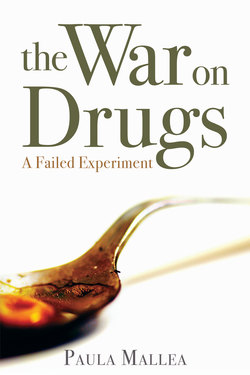Читать книгу The War on Drugs - Paula Mallea - Страница 9
На сайте Литреса книга снята с продажи.
Chapter Four
ОглавлениеCocaine: White Lines
Direct Health Effects
Cocaine was first synthesized in 1850, and was even promoted by Sigmund Freud as a cure for depression and sexual impotence.[1] In 1886, it became the main ingredient in a new drink, Coca-Cola. Consumers found that it had euphoric and energizing effects. It was widely used up until the early 1900s as an ingredient in various elixirs, cure-all tonics, and beverages.
Cocaine was removed from Coca-Cola in 1903, and in 1920 it was banned in the United States under the Dangerous Drug Act. This prohibition was largely in response to racist attitudes. For example, the New York Times quoted Dr. Edward Huntington Williams denouncing “Negro cocaine ‘fiends.’”[2] Congress heard testimony that “most of the attacks upon white women in the South are the direct result of a cocaine-crazed Negro brain.”[3]
In Canada, cocaine was banned for use in medicines in 1908, and later was included in the list of drugs prohibited by the 1911 Opium and Drugs Act, preceding prohibition in the United States by several years.
Cocaine is derived from the coca plant, which is grown mainly in the high Andes of South America. Indigenous peoples living at high altitudes chew coca leaves to help them deal with cold, hunger, and fatigue. The mild stimulant improves their oxygen intake, a necessity at high altitude, and increases their stamina. Many indigenous peoples consider coca leaf to be sacred, and include it in their ceremonies and traditions.
Cocaine (the white powder processed version of coca leaf) is a powerful stimulant of the central nervous system that creates intense euphoria in the user.[4] It also affects the cardiovascular system, increasing both blood pressure and heart rate. It may be smoked (in its form as crack cocaine), snorted, or injected, and suppresses fatigue, appetite, pain, and the need for sleep. The drug may also induce feelings of agitation or anxiety or, by contrast, of physical and intellectual prowess in the user. Cocaine can be dangerous if mixed with alcohol.
Neuropsychopharmacologist Dr. Carl Hart is one of the few experts to have done clinical trials of human beings using cocaine. He himself believed popular misconceptions about cocaine and other illegal drugs until he began to do the science himself. “When I started applying my critical skills to what I thought I knew about drugs,” he explains, “very little survived.”[5] He uses as an example the hysteria around “crack babies” and how the ONDCP put out a statistic that “wildly overstated” the extent of this problem. He assembled “a mountain of scientific data to call into question some of the purported damaging effects of drugs like cocaine, heroin, and methamphetamine.”
In the face of claims that crack is especially dangerous, Dr. Hart points out that powder and crack cocaine are “qualitatively the same drug.” They are “identical pharmacologically.” The fact that a user might experience more intense highs with crack cocaine than with powder has to do with the ways in which they are ingested. Injecting cocaine, for example (instead of snorting it, which is the more common method), will provide about the same intense response as smoking crack. Dr. Nutt of the U.K. agrees that it is the “route of administration” that determines the intensity of the high experienced.[6]
Dr. Hart also clears up some misconceptions around addiction to cocaine. For example, it is widely believed that after one hit of crack cocaine, a person can become addicted. As he points out, this is false, and even at the height of its widespread use, only 10 to 20 percent of crack users ever became addicted.[7] He also asserts that “physical dependence isn’t the primary reason for continued drug use,” and, unlike heroin or alcohol or tobacco (or even caffeine), cocaine withdrawal does not include physical symptoms. So any dependence or addiction to cocaine must be described as psychological. This is consistent with the WHO definition of addiction as a psychological dependence; that is, “compulsive use of a drug for its mood-altering properties, and continued use despite harm.”[8]
